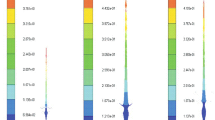Abstract
This paper outlines our research on a multimode warhead in which we adopted center point and annular initiation modes to form multimode penetrators. Using LS-DYNA software, we studied the effect of the configuration parameters, namely the length/diameter ratio of the shaped charge, on the formation parameters, such as the velocity and length/diameter ratio, of multimode penetrators. We found that when the charge length was in the range of 0.9–1.2 times the charge diameter, the same structure of shaped charge can form suitable multimode penetrators. Either an explosively formed penetrator (EFP) or a long stretchy rod-shaped EFP penetrator can be formed. We establish an optimum charge length for penetrator formation of 1.4 times the charge diameter. Simulation results were validated using X-ray imaging experiments and they were in good agreement. The results found that by increasing the charge length from 0.9 to 1.4 times the charge diameter, the penetration depth of the EFP increased by 74.5%, while increasing the charge length from 1.4 to 1.6 times the charge diameter only increased the penetration depth by 1.9%.
Similar content being viewed by others
References
Whelan, A.J.: Multiple effect warheads for defeat of urban structures and armour. In: Proceedings of the 24th International Symposium on Ballistics, New Orleans, Louisiana, pp. 1092–1098 (2008)
Steinmann, F., Lösch, C.: Multimode warhead technology studies. In: Proceedings of the 21th International Symposium on Ballistics, Adelaide, Australia, pp. 728–735 (2004)
Baker, E.L., Daniels, A.S., Turci, J.P. et al.: Selectable initiation shaped charges. In: Proceedings of the 20th International Symposium on Ballistics, Orlando, Florida, USA, pp. 589–596 (2002)
Bender, D., Fong, R., Ng, W. et al.: Dual mode warhead technology for future smart munitions. In: Proceedings of the 19th International Symposium on Ballistics, Interlaken, Switzerland, pp. 679–684 (2001)
Fong, R.: Warhead technology advancements. ADA394848 (2000)
Fong, R.: New, selectable, explosively formed penetrator (EFP) warhead concept. In: Proceedings of the 41st Annual Bomb and Warhead Technical Meeting, San Diego, California, pp. 172–197 (1991)
Li W.B., Wang X.M., Li W.B. et al.: The effect on formation of multimode penetrator with configuration parameter of liner. J. Ballistics 21(1), 19–23 (2009)
Li, W.B., Wang, X.M., Li, W.B., et al.: The effect of shell configuration on the formation of multimode penetrators. In: Proceedings of the 3rd International Conference on Mechanical Engineering and Mechanics. Beijing, P. R. China, pp. 1221–1225 (2009)
Sun Y.B.: Explosion Action and Charge Design. Defence Industry Press, Beijing (1985)
Kennedy, J.E.: Explosive Output for Driving Metal. Behavior and Utilization of Explosives in Engineering Design, vol. 3 (1972)
Beijing Institute of Technology: Explosion and Action. Defence Industry Press, Beijing (1979)
Li W.B., Wang X.M., Li W.B.: The effect of annular multi-point initiation on the formation and penetration of an explosively formed penetrator. Int. J. Impact Eng. 37(4), 414–424 (2010)
Johnson G.R.: Dynamic analysis of explosive–metal interaction in three dimensions. J. Appl. Mech. 103, 30–34 (1981)
Johnson G.R., Stryk R.A.: Some considerations for 3D EFP computations. Int. J. Impact Eng. 32(10), 1621–1634 (2006)
Hallquist, J.O.: LS-DYNA User’s Manual. LSTC, pp. 34–109 (1997)
Wu J., Liu J.B., Du Y.X.: Experimental and numerical study on the flight and penetration properties of explosively-formed projectile. Int. J. Impact Eng. 34(7), 1147–1162 (2007)
Johnson, G.R., Cook, W.H.: A constitutive model and data for metals subjected to large strains, high strain rates and high temperatures. In: Proceedings of the 7th International Symposium on Ballistics, Hague, Netherlands, pp. 541–547 (1983)
Livermore LS-DYNA Keyword User’s Manual. California: Livermore Software Technology Corporation, pp. 20–510 (2003)
Author information
Authors and Affiliations
Corresponding author
Additional information
Communicated by C. Needham.
Rights and permissions
About this article
Cite this article
Li, W., Wang, X., Li, W. et al. Research on the optimum length–diameter ratio of the charge of a multimode warhead. Shock Waves 22, 265–274 (2012). https://doi.org/10.1007/s00193-012-0365-z
Received:
Revised:
Accepted:
Published:
Issue Date:
DOI: https://doi.org/10.1007/s00193-012-0365-z



